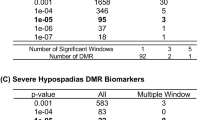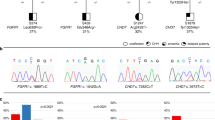Abstract
Hypospadias is a common congenital condition in boys in which the urethra opens on the underside of the penis. We performed a genome-wide association study on 1,006 surgery-confirmed hypospadias cases and 5,486 controls from Denmark. After replication genotyping of an additional 1,972 cases and 1,812 controls from Denmark, the Netherlands and Sweden, 18 genomic regions showed independent association with P < 5 × 10−8. Together, these loci explain 9% of the liability to developing this condition. Several of the identified regions harbor genes with key roles in embryonic development (including HOXA4, IRX5, IRX6 and EYA1). Subsequent pathway analysis with GRAIL and DEPICT provided additional insight into possible genetic mechanisms causing hypospadias.
This is a preview of subscription content, access via your institution
Access options
Subscribe to this journal
Receive 12 print issues and online access
$209.00 per year
only $17.42 per issue
Buy this article
- Purchase on Springer Link
- Instant access to full article PDF
Prices may be subject to local taxes which are calculated during checkout



Similar content being viewed by others
References
Schnack, T.H. et al. Familial aggregation of hypospadias: a cohort study. Am. J. Epidemiol. 167, 251–256 (2008).
Baskin, L.S. et al. Urethral seam formation and hypospadias. Cell Tissue Res. 305, 379–387 (2001).
van der Zanden, L.F. et al. Aetiology of hypospadias: a systematic review of genes and environment. Hum. Reprod. Update 18, 260–283 (2012).
Baskin, L.S. & Ebbers, M.B. Hypospadias: anatomy, etiology, and technique. J. Pediatr. Surg. 41, 463–472 (2006).
Kalfa, N., Philibert, P. & Sultan, C. Is hypospadias a genetic, endocrine or environmental disease, or still an unexplained malformation? Int. J. Androl. 32, 187–197 (2009).
van der Zanden, L.F. et al. Common variants in DGKK are strongly associated with risk of hypospadias. Nat. Genet. 43, 48–50 (2011).
1000 Genomes Project Consortium. A map of human genome variation from population-scale sequencing. Nature 467, 1061–1073 (2010).
Pruim, R.J. et al. LocusZoom: regional visualization of genome-wide association scan results. Bioinformatics 26, 2336–2337 (2010).
Wang, K., Li, M. & Hakonarson, H. ANNOVAR: functional annotation of genetic variants from high-throughput sequencing data. Nucleic Acids Res. 38, e164 (2010).
Kumar, P., Henikoff, S. & Ng, P.C. Predicting the effects of coding non-synonymous variants on protein function using the SIFT algorithm. Nat. Protoc. 4, 1073–1081 (2009).
Adzhubei, I.A. et al. A method and server for predicting damaging missense mutations. Nat. Methods 7, 248–249 (2010).
Chun, S. & Fay, J.C. Identification of deleterious mutations within three human genomes. Genome Res. 19, 1553–1561 (2009).
Schwarz, J.M., Rodelsperger, C., Schuelke, M. & Seelow, D. MutationTaster evaluates disease-causing potential of sequence alterations. Nat. Methods 7, 575–576 (2010).
Geller, F. et al. Genome-wide association study identifies four loci associated with eruption of permanent teeth. PLoS Genet. 7, e1002275 (2011).
Fatemifar, G. et al. Genome-wide association study of primary tooth eruption identifies pleiotropic loci associated with height and craniofacial distances. Hum. Mol. Genet. 22, 3807–3817 (2013).
Estrada, K. et al. Genome-wide meta-analysis identifies 56 bone mineral density loci and reveals 14 loci associated with risk of fracture. Nat. Genet. 44, 491–501 (2012).
Wain, L.V. et al. Genome-wide association study identifies six new loci influencing pulse pressure and mean arterial pressure. Nat. Genet. 43, 1005–1011 (2011).
Ehret, G.B. et al. Genetic variants in novel pathways influence blood pressure and cardiovascular disease risk. Nature 478, 103–109 (2011).
Gudmundsson, J. et al. Genome-wide association and replication studies identify four variants associated with prostate cancer susceptibility. Nat. Genet. 41, 1122–1126 (2009).
Repapi, E. et al. Genome-wide association study identifies five loci associated with lung function. Nat. Genet. 42, 36–44 (2010).
Elks, C.E. et al. Thirty new loci for age at menarche identified by a meta-analysis of genome-wide association studies. Nat. Genet. 42, 1077–1085 (2010).
Raychaudhuri, S. et al. Identifying relationships among genomic disease regions: predicting genes at pathogenic SNP associations and rare deletions. PLoS Genet. 5, e1000534 (2009).
Westra, H.J. et al. Systematic identification of trans eQTLs as putative drivers of known disease associations. Nat. Genet. 45, 1238–1243 (2013).
Yang, J., Lee, S.H., Goddard, M.E. & Visscher, P.M. GCTA: a tool for genome-wide complex trait analysis. Am. J. Hum. Genet. 88, 76–82 (2011).
Lee, S.H., Wray, N.R., Goddard, M.E. & Visscher, P.M. Estimating missing heritability for disease from genome-wide association studies. Am. J. Hum. Genet. 88, 294–305 (2011).
Carmichael, S.L. et al. Diacylglycerol kinase K variants impact hypospadias in a California study population. J. Urol. 189, 305–311 (2013).
Chen, T. et al. Mutation screening of BMP4, BMP7, HOXA4 and HOXB6 genes in Chinese patients with hypospadias. Eur. J. Hum. Genet. 15, 23–28 (2007).
Stelnicki, E.J. et al. HOX homeobox genes exhibit spatial and temporal changes in expression during human skin development. J. Invest. Dermatol. 110, 110–115 (1998).
Goodman, F.R. & Scambler, P.J. Human HOX gene mutations. Clin. Genet. 59, 1–11 (2001).
Morgan, E.A., Nguyen, S.B., Scott, V. & Stadler, H.S. Loss of Bmp7 and Fgf8 signaling in Hoxa13-mutant mice causes hypospadia. Development 130, 3095–3109 (2003).
Bonini, N.M., Leiserson, W.M. & Benzer, S. The eyes absent gene: genetic control of cell survival and differentiation in the developing Drosophila eye. Cell 72, 379–395 (1993).
Wang, C. et al. Six1 and Eya1 are critical regulators of peri-cloacal mesenchymal progenitors during genitourinary tract development. Dev. Biol. 360, 186–194 (2011).
Chiu, H.S. et al. Comparative gene expression analysis of genital tubercle development reveals a putative appendicular Wnt7 network for the epidermal differentiation. Dev. Biol. 344, 1071–1087 (2010).
Michailidou, K. et al. Large-scale genotyping identifies 41 new loci associated with breast cancer risk. Nat. Genet. 45, 353–361 (2013).
Jostins, L. et al. Host-microbe interactions have shaped the genetic architecture of inflammatory bowel disease. Nature 491, 119–124 (2012).
Anttila, V. et al. Genome-wide meta-analysis identifies new susceptibility loci for migraine. Nat. Genet. 45, 912–917 (2013).
Devlin, B. & Roeder, K. Genomic control for association studies. Biometrics 55, 997–1004 (1999).
Marchini, J. & Howie, B. Genotype imputation for genome-wide association studies. Nat. Rev. Genet. 11, 499–511 (2010).
Delaneau, O., Marchini, J. & Zagury, J.F. A linear complexity phasing method for thousands of genomes. Nat. Methods 9, 179–181 (2012).
Howie, B.N., Donnelly, P. & Marchini, J. A flexible and accurate genotype imputation method for the next generation of genome-wide association studies. PLoS Genet. 5, e1000529 (2009).
Purcell, S. et al. PLINK: a tool set for whole-genome association and population-based linkage analyses. Am. J. Hum. Genet. 81, 559–575 (2007).
Willer, C.J., Li, Y. & Abecasis, G.R. METAL: fast and efficient meta-analysis of genomewide association scans. Bioinformatics 26, 2190–2191 (2010).
Higgins, J.P. & Thompson, S.G. Quantifying heterogeneity in a meta-analysis. Stat. Med. 21, 1539–1558 (2002).
Siepel, A., Pollard, K. & Haussler, D. New methods for detecting lineage-specific selection. Proc. 10th Int. Conf. Res. Comput. Mol. Biol. (RECOMB 2006), 190–205 (2006).
Davydov, E.V. et al. Identifying a high fraction of the human genome to be under selective constraint using GERP. PLoS Comput. Biol. 6, e1001025 (2010).
Cvejic, A. et al. SMIM1 underlies the Vel blood group and influences red blood cell traits. Nat. Genet. 45, 542–545 (2013).
Lage, K. et al. A human phenome-interactome network of protein complexes implicated in genetic disorders. Nat. Biotechnol. 25, 309–316 (2007).
Bult, C.J., Eppig, J.T., Blake, J.A., Kadin, J.A. & Richardson, J.E. The mouse genome database: genotypes, phenotypes, and models of human disease. Nucleic Acids Res. 41, D885–D891 (2013).
Croft, D. et al. Reactome: a database of reactions, pathways and biological processes. Nucleic Acids Res. 39, D691–D697 (2011).
Kanehisa, M., Goto, S., Sato, Y., Furumichi, M. & Tanabe, M. KEGG for integration and interpretation of large-scale molecular data sets. Nucleic Acids Res. 40, D109–D114 (2012).
Ashburner, M. et al. Gene ontology: tool for the unification of biology. The Gene Ontology Consortium. Nat. Genet. 25, 25–29 (2000).
Frey, B.J. & Dueck, D. Clustering by passing messages between data points. Science 315, 972–976 (2007).
Bodenhofer, U., Kothmeier, A. & Hochreiter, S. APCluster: an R package for affinity propagation clustering. Bioinformatics 27, 2463–2464 (2011).
Saito, R. et al. A travel guide to Cytoscape plugins. Nat. Methods 9, 1069–1076 (2012).
Livak, K.J. & Schmittgen, T.D. Analysis of relative gene expression data using real-time quantitative PCR and the 2−ΔΔCT Method. Methods 25, 402–408 (2001).
Cuzick, J. A Wilcoxon-type test for trend. Stat. Med. 4, 87–90 (1985).
Acknowledgements
We thank all study participants (as well as their parents) in Denmark, the Netherlands, Sweden and the United States for their cooperation in this study. We would also like to thank everyone involved in data collection and biological material handling in the four study groups (C.H.W. Wijers, S. van der Velde-Visser, K. Kwak, J. Knoll, R. de Gier, B. Kortmann, A. Paauwen, H.G. Kho, J. Driessen and the anesthesiologists of OR 18 for the Dutch group; data collection in the Netherlands was performed as part of a PhD project supported by the Radboud University Medical Center).
B.F. is supported by an Oak Foundation fellowship. T.H.P. is supported by the Danish Council for Independent Research Medical Sciences (FSS) and the Alfred Benzon Foundation. The study was supported by an FSS grant (0602-01455B), the Novo Nordisk Foundation, the Lundbeck Foundation (421/06), the Swedish Research Council, Foundation Frimurare Barnhuset Stockholm, the Stockholm City Council, the Swedish Society for Medical Research and Karolinska Institutet. Funding support for expression analysis performed at the University of California, San Francisco came from the National Institute of Diabetes and Digestive and Kidney Diseases (NIDDK)-sponsored K12 Urologic Research (KURe) program (5K12DK083021). The funders had no role in study design, execution or analysis or in manuscript writing.
Author information
Authors and Affiliations
Contributions
F.G., B.F. and M.M. wrote the first draft of the manuscript. F.G., B.F., L.C. and T.H.P. analyzed the data. I.A.L.M.v.R., I.B.K., T.H.S., M.V.H., W.F.J.F., N.R., D.M.H., A.N. and L.F.M.v.d.Z. contributed by collecting phenotype data and/or setting up the samples for genotyping. T.H.P., J.M.K., J.N.H. and L.F. developed the DEPICT analysis. S.C. and L.S.B. planned, performed and analyzed the expression experiment. F.G., B.F. and M.M. planned and supervised the work. All authors contributed to writing the final manuscript.
Corresponding author
Ethics declarations
Competing interests
The authors declare no competing financial interests.
Supplementary information
Supplementary Text and Figures
Supplementary Figures 1–6 (PDF 2994 kb)
Supplementary Tables 1–13
Supplementary Tables 1–13 (XLSX 606 kb)
Rights and permissions
About this article
Cite this article
Geller, F., Feenstra, B., Carstensen, L. et al. Genome-wide association analyses identify variants in developmental genes associated with hypospadias. Nat Genet 46, 957–963 (2014). https://doi.org/10.1038/ng.3063
Received:
Accepted:
Published:
Issue Date:
DOI: https://doi.org/10.1038/ng.3063
This article is cited by
-
Role of HOXA1-4 in the development of genetic and malignant diseases
Biomarker Research (2024)
-
Role of epigenetics in the etiology of hypospadias through penile foreskin DNA methylation alterations
Scientific Reports (2023)
-
Genome-wide interaction and pathway-based identification of key regulators in multiple myeloma
Communications Biology (2019)
-
Conditional deletion of platelet derived growth factor receptor alpha (Pdgfra) in urorectal mesenchyme causes mesenchyme apoptosis and urorectal developmental anomalies in mice
Cell Death & Differentiation (2019)
-
Single-nucleotide and copy-number variance related to severity of hypospadias
Pediatric Surgery International (2018)



